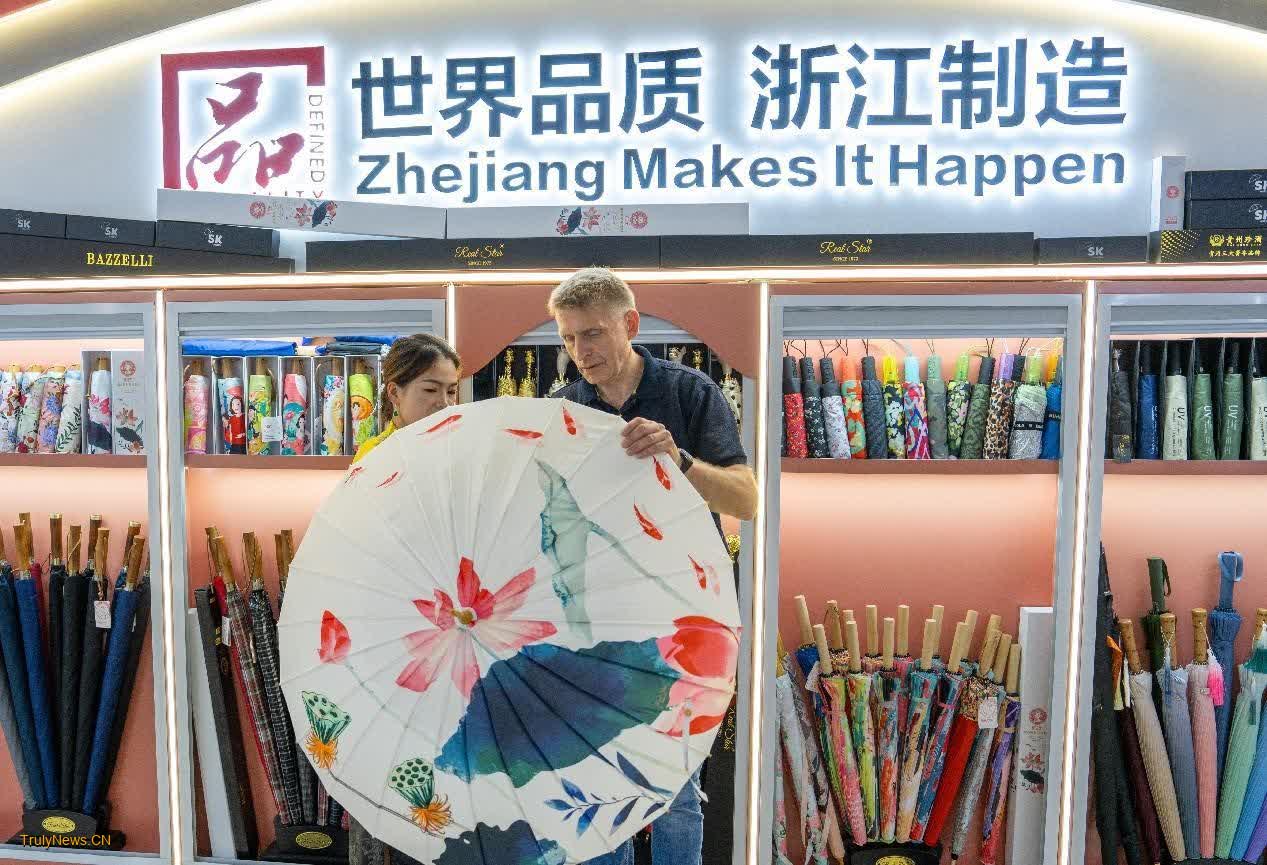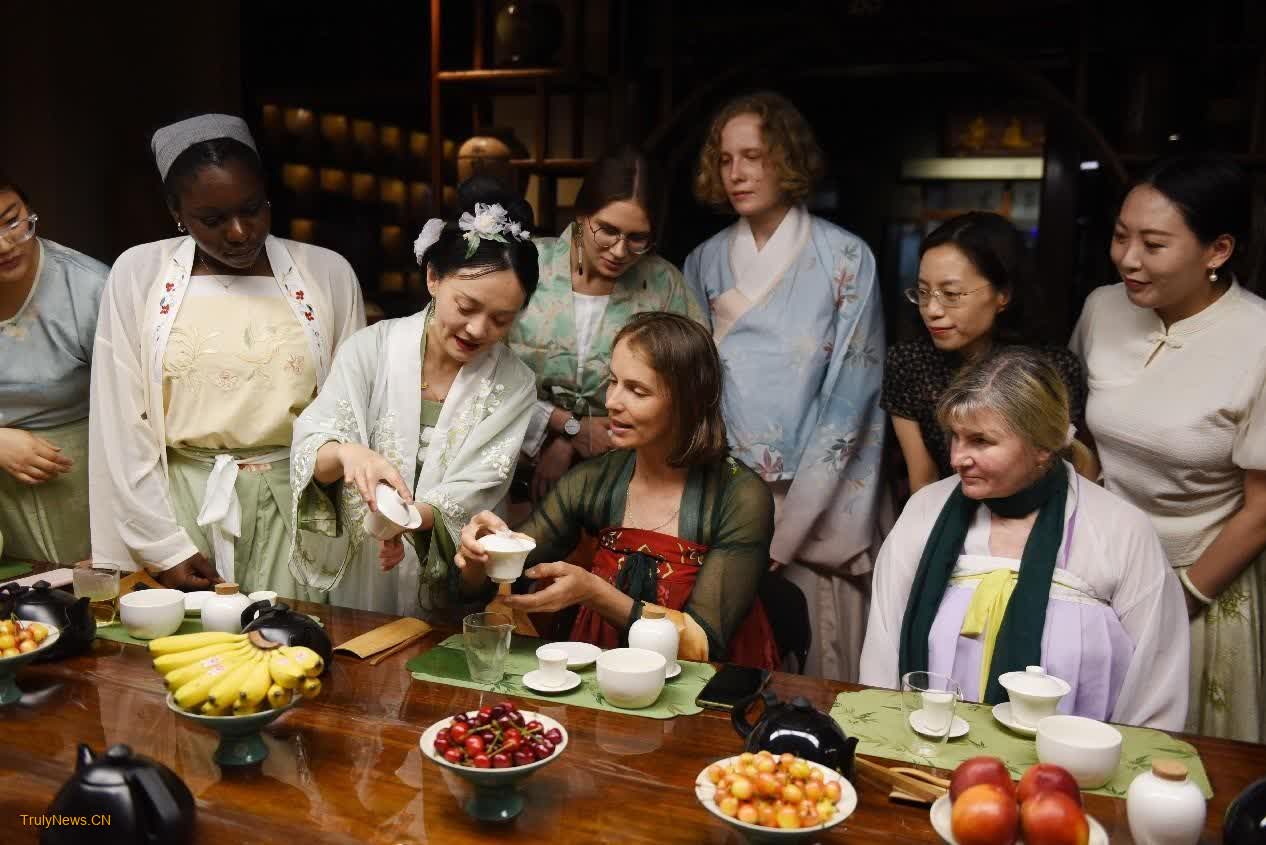Thanks to the vogue for horse-faced skirts, neo-Chinese styles and other Chinese fashion trends around the world, jacquard fabrics and products independently developed by a Zhejiang-based fabric company are seeing booming sales in overseas markets.
In the first five months of this year, the company exported over 40 million yuan ($5.5 million) of such fabrics and products, successfully opening up markets in the Middle East, Africa, Europe, and other regions.

A foreigner shops umbrella in the Yiwu International Trade Market in Yiwu, east China’s Zhejiang province. (People’s Daily Online/Yang Meiqing)
Apart from traditional Chinese attire, Chinese calligraphy, painting, porcelain, and other products are also hitting the European market via China-Europe Railway Express. Chinese beauty brands are gaining a large number of followers on overseas social media platforms as well.
The combination of traditional culture and Chinese manufacturing is driving a “going global” trend of Chinese consumer goods, highlighting China’s foreign trade and conveying the sector’s new momentum of high-quality development to the world.
What drives this trend is the relentless effort of Chinese companies to upgrade their manufacturing processes.
In Suzhou, east China’s Jiangsu province, a silk fabric company has established a technology-driven development model, following the trends of technological innovation, industrial upgrading, and consumer demand.

Foreigners experience Chinese tea culture in a teahouse in Rizhao, east China’s Shandong province. (People’s Daily Online/Fang Dehua)
The company’s independently developed automated farming system for young silkworms enables automated and intelligent production. The company has built an efficient and stable system that covers the entire industrial chain, from a single mulberry leaf or cocoon to a silk thread and ultimately the final product, providing a solid foundation for producing high-quality silk fabrics.
Whether it is silk, porcelain, or attire, Chinese-style consumer goods have distinct cultural characteristics and are imbued with rich cultural connotations.
Many companies are exploring the multidimensional expression of traditional Chinese culture through inheritance and innovation. For instance, they collaborate with museums and historical blocks to develop co-branded products, and combine traditional culture with contemporary popular art and daily necessities.
At the recent China (Shenzhen) International Cultural Industries Fair, visitors were treated to an impressive display of cultural creativity. The diverse and beautifully crafted exhibits showcased fresh ways of expressing culture, giving traditional elements a modern twist and bringing new vitality to them.

A Hungarian student joins a traditional Chinese costume cultural week activity in Jiaxing, east China’s Zhejiang province, Nov. 4, 2023. (People’s Daily Online/Lu Xin)
How can a traditional oil-paper umbrella quickly find its way into the homes of overseas consumers? With support and guidance from Hangzhou Customs, a tech firm in Hangzhou, Zhejiang province has started cross-border e-commerce retail business. Currently, the company ships nearly 100 orders of oil-paper umbrellas to its overseas clients on a daily basis.
Cross-border e-commerce bridges manufacturing and consumption, opening a new window for foreign consumers to explore Chinese culture and purchase Chinese goods. It also provides a fresh channel for “China chic” products to go global.
According to Hangzhou Customs, from January to May, Zhejiang province exported 61.99 billion yuan worth of cultural products, up 12.2 percent year-on-year. This showcases Chinese companies’ proactive efforts to adapt and expand their trade methods.
It is believed that as more Chinese companies delve deeper into the essence of traditional culture to launch high-quality products and strengthen their brands abroad, Chinese-style products will receive more orders in overseas markets, thus showcasing the new charm of Chinese manufacturing on the world stage.